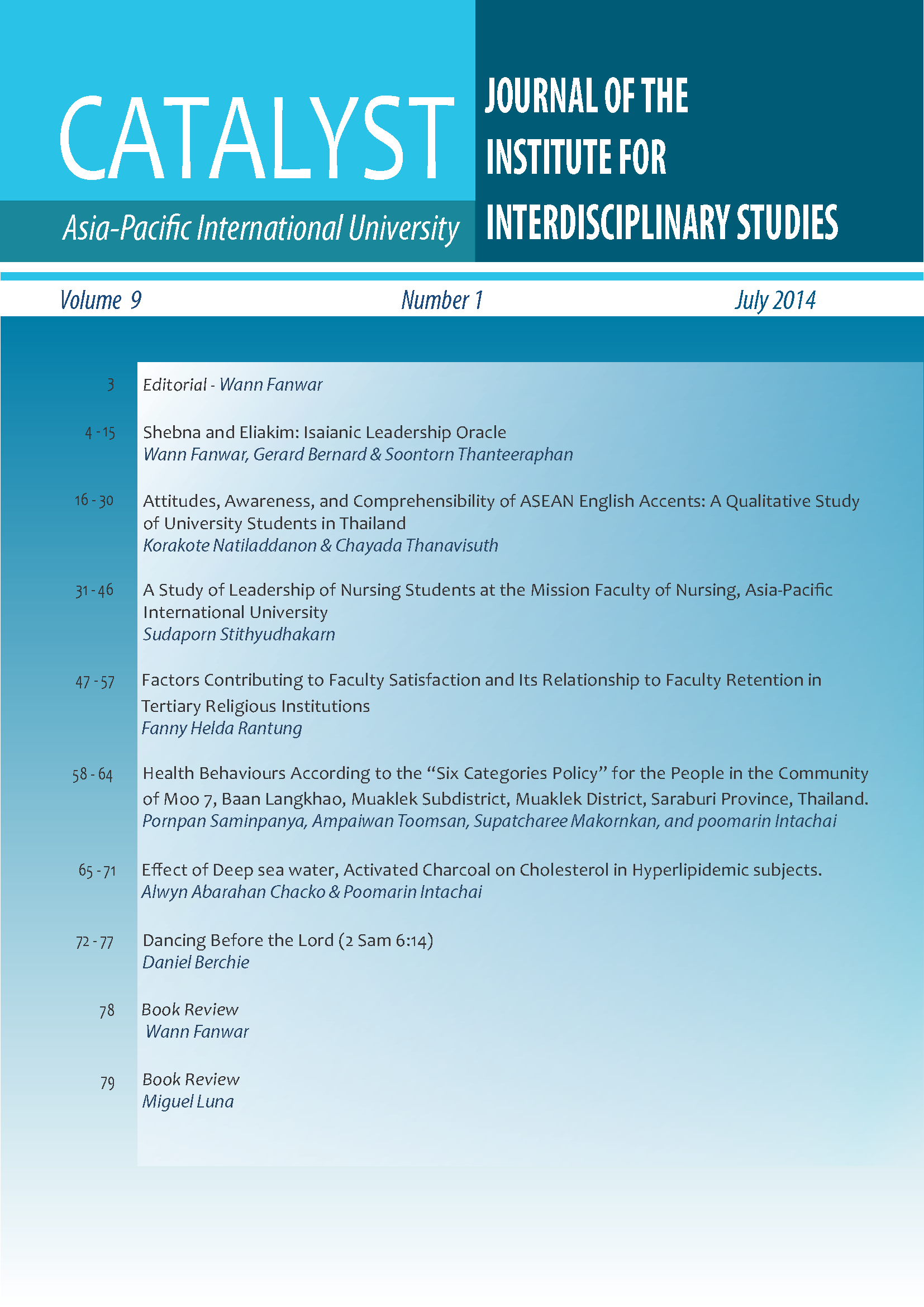Dancing Before the Lord (2 Sam 6:14)
Main Article Content
Abstract
The issue of dancing in church has been a debate among scholars, especially Seventh-day Adventists. David’s dancing before the Lord has been argued to either support or disallow the ritual of dancing in a church (1 Sam 6:14). This paper, however, argues that the dancing of David occurs in a Cultic setting where sacrifices are offered before the ark of God, the symbol of the presence of YHWH. In this setting of worship, David is said to have danced before the Lord as a form of praise to the Lord. David considered God as the object of his dance. Any dance whose object is God may be considered appropriate and religiously necessary in an African context.
Article Details

This work is licensed under a Creative Commons Attribution-NonCommercial-NoDerivatives 4.0 International License.
Copyright: Asia-Pacific International University reserve exclusive rights to publish, reproduce and distribute the manuscript and all contents therein.
References
Anderson, A. A. (1989). 2 Samuel. Word Biblical Commentary. Dallas, TX: Word.
Bacchiocchi , S. (Ed.). (2000). The Christian & rock music: A study on biblical principles of music. Berrien Springs: Biblical Perspectives.
Bergen, R. D. (1996). 1, 2 Samuel. The New American Commentary. Nashville, TN: Broadman & Holman.
Brown, F., S. R. Driver, & C. A. Briggs. (1952). A Hebrew and English lexicon of the Old Testament with an appendix containing the Biblical Aramaic. Based on the lexicon of William Gesenius. S.v. ’arôn, kārar.
Brueggemann, W. (1990). First and second Samuel: Interpretation. Atlanta: John Knox. Case, S. (n.d.) Shall We Dance? Retrieved Januar 4, 2013 from http://dialogue.adventist.org/articles/06_2_ case_e.htm
Christian, E. (2002). The Christian and rock music: A review essay. Journal of Adventist Theological Society, 13(1), 164-68.
Cole, R. D. (2002). Old Testament Narrative: Telling the Story of God’s Handiwork in History. In B. Corley, S. W. Lemke, & G. I. Lovejoy (Eds.), Biblical Hermeneutics: A Comprehensive Introduction to Interpreting Scripture (2nd ed.). Nashville, TN: Broadman.
Nichol, F. D. (Ed.). (1976-80). Despised Him (2 Sam 6:16). The Seventh-day Adventist Bible Commentary, (Vol. 2). Washington, DC: Review & Herald.
Evans, M. J. (2004). The Message of Samuel: Personalities, Potential, Politics and Power. Leicester, UK: Inter-Varsity.
Gillespie, T. (1992). Dancing to the Lord. In S. Case (Ed.), Shall We Dance? Rediscovering Christ-Centered Standards. Riverside, California.
Gordon, R P. (2004). I & II Samuel: A commentary. Carlisle, UK: Paternoster.
Van Groningen, G. (1980). Theological wordbook of the Old Testament. Chicago: Moody.
Kautzch, E. (n.d.). Gesenius’ Hebrew grammar. (2nd ed.). Oxford: Clarendon.
Koranteng-Pipim, S. (n.d.). Applause, hand-waiving, drumming, & dancing in the church: Some preliminary reflections on some current issues on worship. Retrieved January 4, 2013 from http://www.drpipim. org/index.php? option=com_content&task=view&id= 108&Itemid=48
Knott, B. (1992). Shall we dance? In S. Case (Ed.), Shall We Dance? Rediscovering Christ-Centered Standards. Riverside, California.
Music in Africa. (2011). Wikipedia, the free encyclopaedia. Retrieved July 28, 2011 from http://en.wikipedia. org/wiki/Music_of_Africa.
Nix, J. R. (2006). Growing up Adventist: No apologies needed. Adventist Review. Retrieved January 10, 2013 http://www.adventistreview.org/issue.php?issue=2006-1509&page=8
Seventh-day Adventist Church Manual (2010). Retrieved July 28, 2011, from http://www.adventist.org/ assets/Church_Manual_Session_Minutes_Version.pdf
Smith, J.E. (2000). The College Press NIV Commentary: 1 & 2 Samuel. Joplin, Missouri: College.
Youngblood, R. F. (1976). 1, 2 Samuel. In F. E. Gaebelein (Ed.), The Expositor’s Bible Commentary with the New International Version of the Holy Bible, (Vol. 3). Grand Rapids, MI: Zondervan.
Waltke, B. K. & M. O’Connor. (1990). An introduction to biblical Hebrew syntax. Winona Lake, IN: Eisenbrauns, 1990.
White, E. G. (1952). The Adventist home. Washington, DC: Review and Herald.


